#i i i was half alsepe
Text
I just remembered din college when I would write all ym half alsepe thought son tumblr and then I had to update ethe bathroom newsletter and I would have a thoughts of the week section and just search through my text posts
3 notes
·
View notes
Text
what do you get when you combine you, me, and a desert plant?
CACT-US
4 notes
·
View notes
Text
walker harasssing civilians ...... someone get ridda this guy
#im literally half alsepe lmaoo it’ll be a miracle if i finish the episode tonight#brot watches tfatws
0 notes
Text
this is a @botanicallyinclinednerd apreiating post becase she gets me even wshen im half alsep lvi i love you and you spedy delirosu faye language learning thingy uh tehr the word is
I dont knwo the word but you platonic soulamte two sides of the same coin
5 notes
·
View notes
Text
50 Years Ago: Apollo 12 – The Journey Home
NASA - Apollo 12 Mission patch.
Nov. 21, 2019
Apollo 12 astronauts Charles “Pete” Conrad and Alan L. Bean were in high spirits when they re-entered their Lunar Module (LM) Intrepid on the Moon’s Ocean of Storms. They had completed two Extravehicular Activities (EVAs) or spacewalks on the lunar surface, spending a total of 7 hours and 45 minutes outside. One the second EVA, they paid a visit to Surveyor 3, a robotic spacecraft that had landed nearby in April 1967, and snipped off several parts of the spacecraft to return them to Earth for scientists and engineers to assess the effects of 31 months in the harsh lunar environment. Conrad and Bean collected 76 pounds of lunar rocks, soil, and core samples, safely stowed in two Sample Return Containers (SRC). Inside the LM they prepared to liftoff from the surface and rejoin the third Apollo 12 crewmember, Richard F. Gordon, who continued to orbit the Moon in the Command Module (CM) Yankee Clipper, taking photographs and making other observations.
Left: View from Conrad’s window after EVA2 showing some of Intrepid’s thrusters
and a few footprints. Right: View from Bean’s window after EVA2, showing a profusion
of footprints in the lunar dust, the American flag, and the S-band antenna’s shadow.
When they returned inside Intrepid, Conrad and Bean used up their remaining film by taking photographs out the windows, showing the signs of their visit – numerous footprints, the American flag, the S-band antenna, and in the distance, the Apollo Lunar Surface Experiment Package (ALSEP) station. They jettisoned their Portable Life Support System (PLSS) backpacks, gloves, and cameras, and ate a meal, after which Conrad said they were ready to “have a little chitty chat about the EVA” with Capcom Edward G. Gibson. In that conversation, Conrad said, “Al and I look just like a couple of bituminous coal miners right at the moment. But we’re happy.” To which Gibson replied, “So are a lot of people down here.” Gordon, coming around the Moon’s front side on his 28th revolution, congratulated Conrad and Bean on a job well done. To prepare for liftoff, Conrad and Bean tested Intrepid’s Reaction Control System (RCS) thrusters. The firings kicked up a fair bit of dust and also knocked over the S-band antenna, but the vehicle automatically switched to its own antenna with no loss of communications.
Two views in Mission Control during the lunar orbit rendezvous.
As Gordon in Yankee Clipper flew overhead on his 30th lunar revolution, Intrepid’s Ascent Stage engine ignited and Conrad and Bean lifted off from the Moon after 31 hours and 31 minutes on the surface, leaving the Descent Stage behind. Conrad exclaimed, “Liftoff! And away we go!” with Bean adding, “Boy, did it fire!” Even though the astronauts had deployed the ALSEP instruments more than 400 feet from Intrepid, several of the sensitive ones recorded the liftoff – the seismometer detected the vibrations, ion and dust detectors noted spikes in their readings, and the magnetometer recorded field fluctuations for 12 minutes. Ten seconds after liftoff at an altitude of 275 feet, Intrepid pitched over by 45 degrees to begin its climb to orbit. The 7-minute burn placed Intrepid into an intermediate 53-by-10-mile orbit, trailing Yankee Clipper by about 290 miles. The lunar dust that had settled on the floor of the LM floated throughout the cabin now that they were weightless again, so Conrad and Bean elected to keep their suits including helmets on to avoid breathing in the abrasive dust. In a repeat of the Apollo 11 rendezvous sequence Intrepid and Yankee Clipper executed a series of maneuvers that led to their docking about three and a half hours after liftoff from the Moon. Gordon relayed color TV views of the docking to Mission Control. Their independent flights had lasted 37 hours and 42 minutes.
Three stills from 16 mm film recorded aboard Yankee Clipper of Intrepid’s approach just prior to docking.
The three astronauts opened the hatches between the two spacecraft and quickly began transferring all the required items from Intrepid into Yankee Clipper, including all the lunar samples, cameras, and film. Conrad and Bean decided to remove their spacesuits in Intrepid and then transfer them across in an attempt to minimize contaminating Yankee Clipper with lunar dust. Gordon transferred some unneeded items to be jettisoned in Intrepid. The transfers completed, they closed the hatches between the spacecraft and jettisoned the LM. To calibrate the seismometer left on the Moon, controllers sent a command to Intrepid to fire its thrusters for 83 seconds to drop it out of orbit and send it crashing on the surface about 40 miles from the instrument. The seismometer recorded signals for nearly one hour after the impact. Meanwhile, the astronauts prepared for their sleep period after a strenuous nearly 24-hour day.
Recording from the Apollo 12 seismometer of the intentional crash of the LM ascent stage.
Apollo 12 photographs taken on their last day in lunar orbit. Left: Fra Mauro highlands.
Middle: Descartes region. Right: Smyth Sea.
The astronauts began their final day in lunar orbit as they appeared on the Moon’s front side on their 38th revolution. The primary activity for their remaining time around the Moon consisted of photographing potential landing sites for future Apollo missions, such as the Fra Mauro highlands and the Descartes region, as well as targets of opportunity such as the Smyth Sea. To achieve the best orbital track for this task the crew performed a 19-second out-of-plane maneuver using the Service Propulsion System (SPS) engine. On their 45th revolution, they went around to the Moon’s backside for the last time as they fired the SPS for the 2-minute and 10-second Trans Earth Injection (TEI) burn. Apollo 12 left lunar orbit after 3 days 17 hours and 2 minutes. As they rounded from the back side of the Moon, Conrad radioed to Mission Control, “Hello, Houston. Apollo 12’s en route home.” They had already set up the color TV camera and began transmitting views of the rapidly receding Moon. Capcom Don L. Lind commented, “We really get the impression that you’re on a fast elevator,” eliciting this response from Gordon, “Yes, we're really moving out, Don. It doesn't take very long to get some altitude out of that place.” They concluded the 38-minute TV broadcast by filming themselves in the cabin, having already traveled nearly 2,900 miles from the Moon. Shortly thereafter, all three crewmembers began a well-earned sleep period.
Four views of the rapidly receding Moon after TEI.
While the astronauts slept for about 12 hours, Apollo 12 passed from the Moon’s gravitational sphere of influence to the Earth’s and the spacecraft began to accelerate toward its final destination. The first order of business on this crew day involved a minor course correction, at a distance of about 200,000 miles from Earth, a burn of the RCS thrusters of less than five seconds to refine the spacecraft’s trajectory. While Capcom Gibson read up the day’s news to the astronauts, he also reported that their wives Jane Conrad, Barbara Gordon, and Sue Bean greeted reporters that morning outside the Conrads’ house wearing white pantsuits and holding up signs that read, “Proud,” Thrilled,” and “Happy.” Gibson also reported to the crew that the ALSEP experiments were all working as expected. The astronauts answered questions from geologists and other scientists, relayed by Capcoms Gibson and Lind, about their lunar traverses and their impressions of Surveyor 3. The astronauts finished the day with some housekeeping chores, which included frequent cleaning of air filters due to the lunar dust they brought in from the LM, and went to sleep, some 187,000 miles from Earth.
Left: Apollo 12 astronauts’ wives (left to right) Sue Bean, Barbara Gordon, and Jane Conrad hold up signs for reporters. Right: Apollo 12 astronauts (left to right) Gordon, Conrad, and Bean aboard Yankee Clipper during the inflight press conference on the way home from the Moon.
The next morning, the astronauts awoke before Mission Control could call them, and Conrad asked Capcom Paul J. Weitz to send the following tongue-in-cheek message full of Navy slang to Rear Admiral Donald C. Davis, head of the US Navy Recovery Forces aboard the prime recovery ship USS Hornet (CVS-12), “Dear Red Dog, Apollo 12 with three tail-hookers expect recovery ship to make its PIM (Point of Intended Movement) as we have energy for only one pass. Signed Pete, Dick, and Al.” A few minutes later, after the astronauts had a glimpse of Earth now 160,000 miles away, Conrad told Capcom Weitz, “Houston, we just got our first glimpse of you this morning, and there’s not very much of you out there.” With the Sun and the Earth nearly aligned, the astronauts could only see a very thin crescent of their home planet. They passed the halfway mark of their journey home, being an equidistant 126,787 miles from the Moon and Earth. Later in the day, the trio held a televised news conference, with Capcom Gerald P. “Jerry” Carr reading up 13 questions submitted by reporters at the Manned Spacecraft Center, now the Johnson Space Center in Houston. At the end of the 37-minute broadcast the crew held up a homemade sign to the camera that read, “Yankee Clipper sailed with Intrepid to the Sea of Storms, Moon, November 14, 1969,” signed by all three crewmembers. Soon after, the three astronauts turned in for their last night’s sleep in space, only 108,000 miles from their home planet.
Left: The Moon continued to shrink in size as Apollo 12 headed home.
Right: The Earth appeared as a very thin crescent with the Sun almost directly behind it.
To be continued...
Related article:
50 Years Ago: Return to the Moon
https://orbiterchspacenews.blogspot.com/2019/11/50-years-ago-return-to-moon.html
New NASA Study Reveals Origin of Organic Matter in Apollo Lunar Samples
https://orbiterchspacenews.blogspot.com/2019/11/new-nasa-study-reveals-origin-of.html
Related links:
Apollo: https://www.nasa.gov/mission_pages/apollo/index.html
Apollo 12: https://www.nasa.gov/mission_pages/apollo/apollo-12
Images, Text, Credits: NASA/Kelli Mars/JSC/John Uri.
Greetings, Orbiter.ch
Full article
20 notes
·
View notes
Text
‘Peace and hope for all mankind’: the stellar legacy of the last moon landing
by Kathryn Harriss
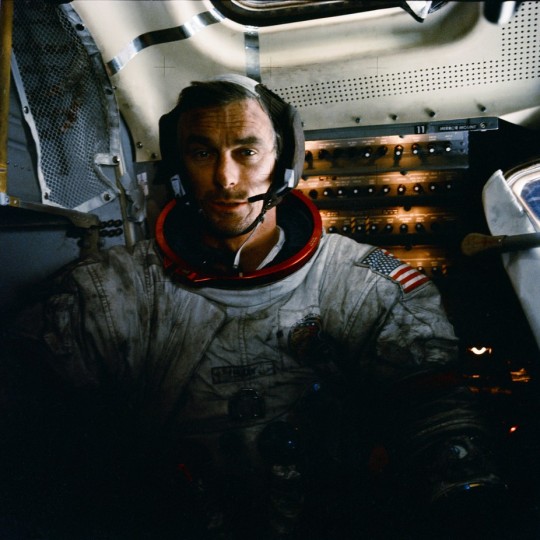
What’s the first thing that comes to mind when you think about the moon landings? Most likely, it’s the statement: “One small step for man, one giant leap for mankind”. These words, spoken by Apollo 11’s Neil Armstrong as he became the first man on the moon, will be quoted and remembered for centuries to come.
But what of the last words spoken by a man on the moon? That man was Eugene Cernan, mission commander of Apollo 17, and his speech ran thus:
As I take man’s last step from the surface, back home for some time to come (but we believe not too long into the future), I’d like to just say what I believe history will record: that America’s challenge of today has forged man’s destiny of tomorrow. And, as we leave the moon at Taurus-Littrow, we leave as we came and, God willing, as we shall return: with peace and hope for all mankind.
In many ways, it is more poignant than Armstrong’s better-known message to the world.
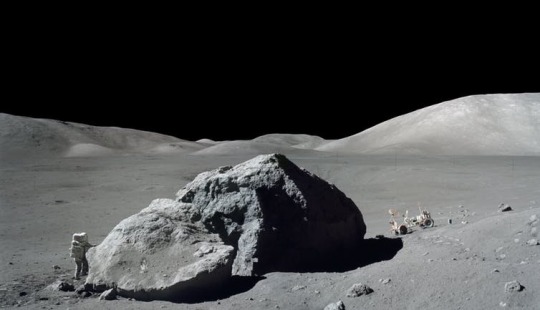
Scientist-astronaut Harrison H. Schmitt photographed standing next to a huge, split lunar boulder during the third Apollo 17 extravehicular activity (EVA) at the Taurus-Littrow landing site. NASA/Eugene Cernan
Indeed, with the recent death of Cernan, aged 82, the broader legacy of the Apollo missions is becoming just that – an increasingly distant legacy. Since Cernan and Harrison “Jack” Schmitt left the lunar surface and returned to Earth with command module pilot Ronald Evans on December 19, 1972, major developments have been made in robotic space flight. But a manned flight hasn’t travelled beyond low Earth orbit in 45 years.
The data and discoveries from the Apollo missions, and especially Apollo 17, are still being investigated today and have allowed us to develop understanding of not only the moon but the character and origin of other terrestrial planets including Earth. They have also given us a stronger sense of our place in the universe – and on our own planet.

Schmitt, Evans and Cernan are photographed with a Lunar Roving Vehicle (LRV) trainer during the rollout of the Apollo 17 rocket. NASA
Apollo 17 was the last of the J class missions which landed in the Taurus-Littrow valley in order to sample both the lunar highland material and investigate relatively new volcanic activity in the same area. The three-day mission broke a number of records, including the longest moon landing and the longest total extravehicular activities (EVAs), or moonwalks (22 hours 6 minutes in total).
It also returned the largest quantity of lunar samples (294 lbs) – thanks in part to Schmitt being a geologist – clocked the longest distance travelled on the surface (35km), and registered the unofficial lunar land speed record (11.2mph, held by Cernan).
youtube
A change in direction
Originally, the Apollo programme planned ten missions to the lunar surface. But in 1970 and 1971, the last three Apollos – 18, 19 and 20 – were cancelled, partly so the Saturn V rocket could be used to launch the first American space station, Skylab, a mission that indicated the change in direction of human space exploration. This meant that when stepping off the lunar surface and into the lunar module for the last time, Cernan was well aware that for the foreseeable future he would be the last human to stand on the surface of another celestial body.
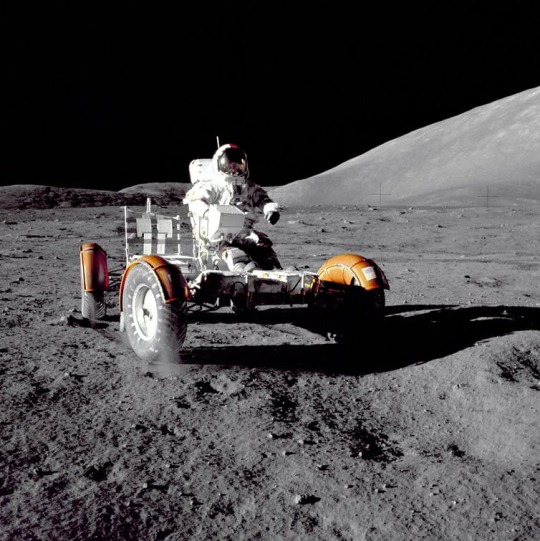
Apollo 17 mission commander Cernan makes a short checkout of the Lunar Roving Vehicle during the early part of the first Apollo 17 extravehicular activity at the Taurus-Littrow landing site. The picture was taken by Schmitt. The mountain in the right background is the east end of South Massif. NASA
It also made the selection process for the crew of Apollo 17 more demanding – this, after all, was the final moonshot. This led to demands in the crew selection and Schmitt, who was originally on the crew for Apollo 18, was swapped into Cernan’s crew, replacing Joe Engle, due to demands from the scientific community that a fully qualified geologist be sent to the moon.
Though Cernan wanted to keep his original crew together, he was happy with the switch believing that Schmitt was an outstanding Lunar Module pilot while Eagle was merely an adequate one
Upon leaving the lunar surface for the last time, Cernan set the lunar rover to record the assent of the module. He then wrote the initials (TDC) of his young daughter, Tracy, in the dust, a timeless message to any who followed him.
Indeed, Cernan long felt that he wanted to share not only the images, samples and data from the moon but also to stop time, reach out and bring the feeling of being on the surface of the moon back home, fully aware that few people would ever have that chance again. He recalled later:
Those steps up that ladder, they were tough to make. I didn’t want to go up. I wanted to stay a while.
The legacy of Apollo 17 was not just in the samples brought back but the images that captivated all on Earth and helped us to recognise our place in the universe. “The Blue Marble” image of Earth was taken by one of the crew, a single frame that shows everyone on Earth with the exception of the three men on the other side of the camera. It also captures the delicate, beautiful nature of our world – and has become one of the most reproduced images in human history.
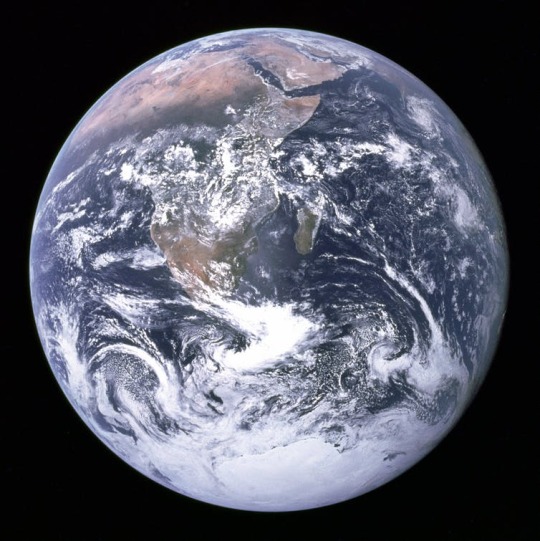
The ‘Blue Marble’ image of Earth, taken by the Apollo 17 crew. NASA
Apollo 17 also had probably the best science return of any Apollo mission. In addition to the Apollo Lunar Surface Experiments Package (ALSEP), which was deployed during all landings from Apollo 12, Apollo 17 also carried the Traverse Gravimeter Experiment. Other experiments included a biological cosmic ray experiment which consisted of five “moon” mice (unofficially named Fe, Fi, Fo, Fum and Phooey) implanted with radiation monitors.
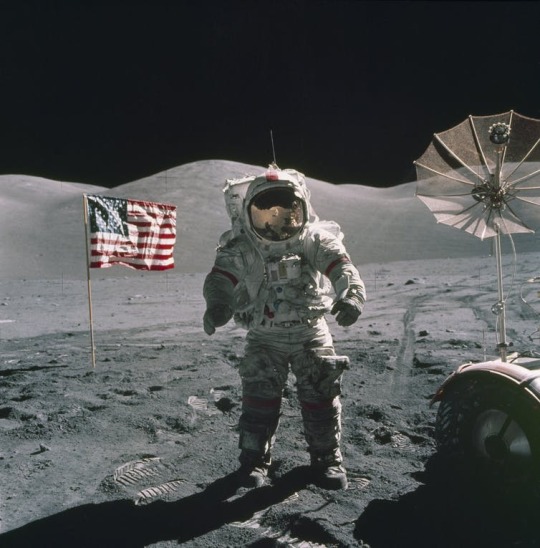
In this photo, taken during the second spacewalk on December 12, 1972, Cernan is standing near the lunar rover. NASA
The Apollo programme laid down the foundations for modern planetary science – and the data and samples brought back have aided our understanding of the origin and evolution of the terrestrial planets. Indeed, one of Apollo 17’s major discoveries was “orange soil”: fine, coloured glass spheres discovered in Shorty crater and theorised to be volcanic in origin.
Since the end of the Apollo programme, manned space flight has changed focus, instead investigating the challenges and methods for humans to survive long periods in space and focusing on space stations such as Mir, SkyLab and the International Space Station (ISS). But the moon is now once again a desirable target for not only the well-established space agencies, but also for China, India and private companies such as SpaceX.
youtube
We can’t ever change the name of the first person on the moon, but nearly half a century after the Apollo landings of the 1960s and 70s, we can change the name of the last. For now, that will remain “Eugene Cernan”, but the achievements, sacrifice and bravery of Cernan and those who went before him, could yet pave the way for a new generation of pioneers. As Cernan wrote in his 1999 memoir:
Too many years have passed for me to still be the last man to have walked on the moon. Somewhere on Earth today is the young girl or boy, the possessor of indomitable will and courage, who will lift that dubious honor for me and take us back out there where we belong.
May humanity return to the moon in the same spirit as Eugene Cernan left it. In these troubling times, there is still good reason to hope.
Kathryn Harriss is a Post-Doctoral Research Associate in Planetary Science at the University of Kent.
This article was originally published on The Conversation.
#space#space exploration#moon landing#nasa#science#technology#science in society#featured#nasa history#science history
343 notes
·
View notes